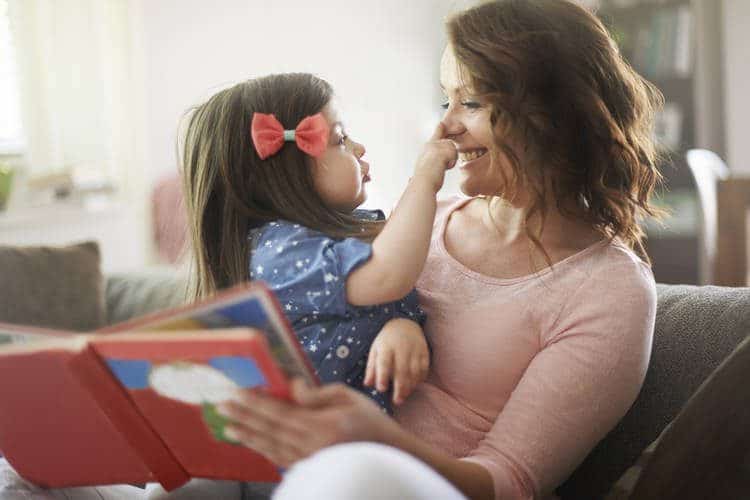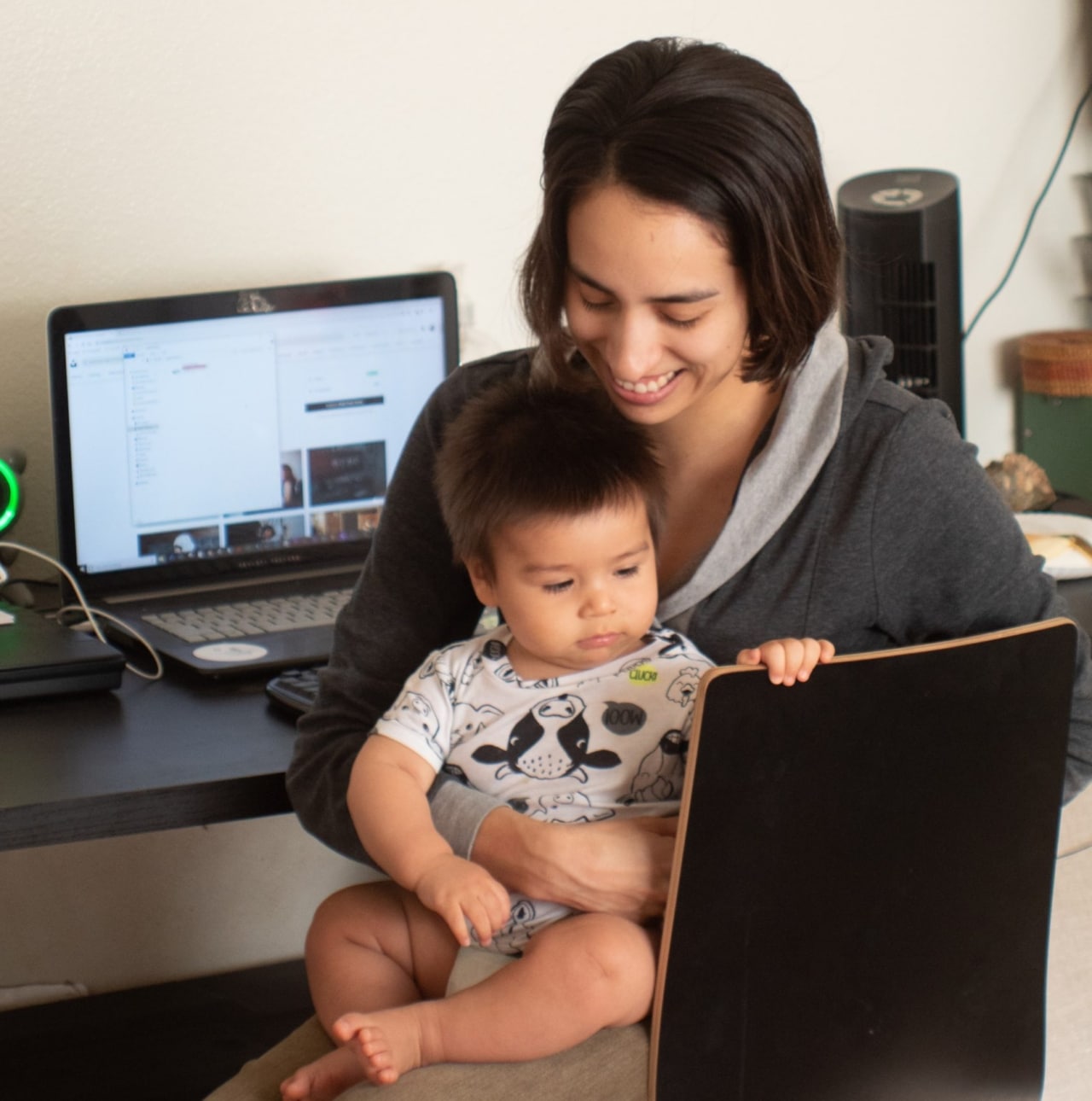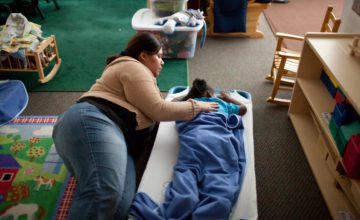Rachel Barr, Georgetown University
Elisabeth McClure, The LEGO Foundation, Billund, Denmark
Rebecca Parlakian, ZERO TO THREE, Washington, DC

Abstract
This article is adapted from Screen Sense: What the Research Says About the Impact of Media on Children Under 3 Years Old (Barr, McClure, & Parlakian, 2018) and related resources, published online at zerotothree.org/screensense. The authors focus on two growing areas of research: how media use influences parent–child relationships and how adults can maximize the positive impacts of media use, while minimizing the negative. Recognizing the growing impact of technology in the lives of young children, the Screen Sense materials provide a tool for guiding parents and professionals in making informed decisions about screen media use to maximize the potential for technology to enhance learning and development.
There is no question that babies today are born into a world of screen media. Where questions remain is what this new world of screen technology means for a child’s development. To highlight the growing research base related to early screen use and children’s learning and outcomes, ZERO TO THREE published Screen Sense: What the Research Says About the Impact of Media on Children Under 3 Years Old (Barr, McClure, & Parlakian, 2018), a literature review highlighting what was currently known about the impact of screen media use on very young children, debunking common myths, and providing recommendations for parents and professionals on maximizing the benefits of screen use and minimizing negative impacts.
What’s New: E-Books, Tablets, and Video Chat
Over the past several years, e-books have appeared on the market and are used by families to share stories with their young children, though 90% of parents continue to prefer print books over e-books (Vaala & Takeuchi, 2012). Indeed, children 2 years and younger spend an average of 20 minutes per day with print books, but only 1 minute on average reading e-books (Rideout, 2017).

Well-designed e-books can be useful tools in early learning, when parents and caregivers guide their children to focus on the story.
E-Book Interactivity
Emerging research has begun to explore the ways in which e-books can be most—and least—supportive of early development. Getting the balance of interactivity right is crucial. Both children and parents can be distracted from the storyline by clicking different hotspots (interactive areas on the screen). A study from the Joan Ganz Cooney Center examined the impact of various degrees of e-book interactivity (Chiong, Ree, Takeuchi, & Erickson, 2012). The researchers asked 32 pairs of parents of 3- to 6-year-olds to read either a traditional print book and a basic e-book, or a traditional print book and an enhanced/highly interactive e-book to their child. The enhanced e-book was less effective than the print and basic e-book in supporting the benefits of co-reading. Children who read the enhanced e-books also recalled significantly fewer narrative details than children who read the print version of the same story. Researchers speculated that because the enhanced e-book prompted more non-content related interactions between parents and children (e.g., discussion about how the device functions or pushing hands away from the device), its features may have detracted from positive co-reading experiences and may have distracted children from the storyline. In contrast, a meta-analysis of 29 studies showed that when adults read well-constructed e-books and traditional books to children, comprehension was equivalent across book types (Takacs, Swart, & Bus, 2015).
For parents, teachers, and caregivers, finding a “just-right” balance of interactivity is critical when selecting e-books and other screen media for young children. Too much interactivity is distracting to children and shifts attention away from comprehension, hindering children’s learning. On the other hand, when interactive features are crafted to support the learning goal, they can enrich preschoolers’ learning (Bus, Takacs, & Kegel, 2015; Strouse & Ganea, 2017; Takacs et al., 2015). Well-designed e-books can be useful tools in early learning, when parents and caregivers guide their children to focus on the story.
Interactive Tablet Use
Parents may believe that they can be less involved when their young children use tablets. In fact, only 25% of parents report co-engaging with their children during tablet use (Rideout, 2017). While children less than 3 years old are capable of learning from interactive touchscreen tablets, they still experience a transfer deficit, or difficulty in applying new learning from the screen to the 3D world (Moser et al., 2015). Yet one study found that high-quality parent joint media engagement (JME; i.e., the actions adults and children take when interacting with media and one another, while using traditional, mobile, and digital devices) was a key strategy for increasing 15-month-old infants’ ability to transfer learning from the touchscreen to an object in the physical world (Zack & Barr, 2016). In other words, parents’ simple explanations and labelling of key features, attempts to organize the task for the baby, and praise and encouragement enhanced transfer of learning, even among very young children typically affected by a transfer deficit. These strategies are the same ones that parents typically use when reading picture books to their young children (Zack & Barr, 2016).
Adults also help guide children when learning a new game on a tablet (Zimmermann, Moser, Lee, Gerhardstein & Barr, 2017). In one study, 2- and 3-year-old children were tasked with assembling a three-piece puzzle. All children in the study learned to assemble the puzzle beforehand by watching a demonstration first, on a touchscreen tablet. Some children learned to assemble the puzzle from a “ghost demonstration” on the tablet, in which the pieces moved themselves into place on the tablet screen. Another group of children watched an adult assemble the puzzle on the tablet screen. The children who watched the adult demonstration were able to assemble the puzzle on the screen, but those who watched the ghost demonstration were not able to assemble the puzzle. This study demonstrated the important role that JME can play in early learning from tablets.
Video Chat
There are many features of video chat that make it well suited to the developmental stage of very young children. For example, while traditional (audio-only) telephones can be challenging for very young children to use, video chat provides a promising altrrnative because it contains two important elements of face-to-face interactions (Ballagas, Kaye, Ames, Go, & Raffle, 2009). First, it allows young children to see the relatives or friends with whom they are interacting, a feature that audio-only telephone calls lack. This visual element could make video calls more meaningful for babies and toddlers, who are highly attuned to faces; and it also means they can use and see non-verbal communication, which is a critical part of early interactions with young children (Ainsworth, Bell, & Stayton, 1974). Second, video calls include social contingency (i.e., serve-and-return interactions), a feature that traditional, one-way videos and television also lack. But video chat may present some new cognitive challenges for young children as well: there may be audio or video delays; there is no physical contact with their social partner; and eye contact is often misaligned, based on the location of video cameras. These components can make it more challenging for young children to share attention with their social partner on video chat (McClure & Barr, 2016).
Just like with e-books and videos, adults can help young children by scaffolding the child’s participation in the interaction. Families can use creative methods to share play activities, read together, and engage in other highly interactive, joyful interactions with the adult partner on video chat. For example, a parent holding a toddler while he speaks to his grandparent can kiss or tickle the child, on behalf of the grandparent, at the end of a shared rhyme. Parents can also explain Internet delays and help mediate confusion caused by eye contact misalignment (McClure, Chentsova-Dutton, Barr, Holochwost, & Parrott, 2015). By using many of the same warm, engaging interaction methods that support high-quality face-to-face interactions, families can make use of video chat to maintain long-distance relationships between their children and their remote loved ones (McClure & Barr, 2016; McClure et al., 2015; McClure, Chentsova-Dutton, Holochwost, Parrott, & Barr, 2018).
When young children engage in video chat interactions, they may not experience the same transfer deficit evident in prerecorded videos. In one study, for example, toddlers between 24 and 30 months old were able to learn new verbs via video chat interactions as well as they did in traditional face-to-face interactions (Roseberry, Hirsh-Pasek, & Golinkoff, 2014). These findings reinforce the critical role that responsive, serve-and-return interactions play in early learning. In another study, babies and toddlers 12 to 25 months old learned novel words, actions, and patterns from adults more effectively in video chat versus pre-recorded videos (Myers, LeWitt, Gallo, & Maselli, 2017). Children who interacted with adults via video chat learned more novel patterns and words than those who viewed a pre-recorded video; and only those children who used video chat responded contingently to their adult partners, and recognized and preferred their adult partner 1 week later (Myers et al., 2017).
Another study found that children (24–30 months old) looked to their co-viewer during video chat more often, remained engaged longer (e.g., looked, vocalized, and imitated more), and learned more when their co-viewer was responsive, versus unresponsive (Myers, Crawford, Murphy, Aka-Ezoua, & Felix, 2018). Findings from the studies on video chat demonstrated that, while children under 2 years old learn better in-person than from video, they do show learning from video chat, probably because video chat retains the back-and-forth (“serve and return”) responsiveness of in-person social interaction.
Putting the Research to Work
In 2015, scientists summarized decades of work from the Science of Learning into four guidelines describing how children learn best, which they called “The Four Pillars of Learning” (Hirsh-Pasek et al., 2016). These four pillars can be used by parents, teachers, and other adults to help identify high-quality children’s media. They can be easily remembered by the acronym “E-AIMS”: Content that is Engaging, Actively Involves the child, is Meaningful, and Social.

Video chat may present some new cognitive challenges for young children because there may be audio or video delays; there is no physical contact with their social partner; and eye contact is misaligned, based on the location of video cameras.
Engaging
Children learn best when they are engaged with the material and undistracted by features that are unrelated to the main content. The engaging features should have a purpose: to focus the child’s attention on a consistent learning goal.
An example of appropriate engagement can be found in emerging research on the ways in which e-books can be most—and least—supportive of early development. Getting the balance of interactivity right is crucial. Both children and parents can be distracted from the storyline by clicking different hotspots (interactive areas on the screen). One study showed that when using early versions of e-readers, parents tended to focus more on the technology and less on the story, guiding their children to click on e-readers’ different features, such as touching a picture to make a sound. This type of interaction resulted in children recalling very little about what was read, reducing their story comprehension. But when adults read well-designed e-books and traditional books to children, comprehension was equivalent across book types. The authors proposed that e-books should be designed without irrelevant hotspots or distractors, in such a way as to engage the reader and enhance comprehension.

Early childhood may be a particularly vulnerable time for technoference, as young children expect (and need) a great deal of social interaction from others.
Actively Involved
Learning is supported when children are actively involved in the educational content. The key here is that content should be “minds-on,” meaning the child is mentally active, putting mental effort into participating in the content. Research shows that the more active children are as they engage with screen media, the greater their learning. When preschoolers actively attend for longer periods of time to educational programming, they learn more from it. Indeed, programs such as Dora the Explorer and Blue’s Clues, in which characters speak directly to the child and pause for the child’s reply—actively eliciting their participation—have been found to encourage expressive language production and vocabulary.
To study younger children, researchers sometimes use an “object retrieval task” to explore the question of whether children can learn from screens. Imagine an experimenter hides an object, like a sticker, from view while two year olds watch on video or on a tablet. The children are then asked to search for the object on another screen or with real props that are identical to those used in the video. In general, the research shows that the more interactive the touchscreen experience is, the more successful children are at finding the hidden item when they transfer from the tablet to real props.
Meaningful
Children learn best when new concepts are embedded in meaningful experiences and settings that children can relate to. Meaningful content is all about making connections: Content should be integrated in a context that is relevant to children’s lives, linking new information to what is already familiar.
Embedding Learning Into Stories
Video content can be made meaningful by incorporating learning into an engaging storyline, which makes it easier for children under 3 years to learn. For example, the PBS Ready to Learn initiative develops engaging content as well as activities for parents and teachers across multiple media platforms to help families support children’s learning from the Peg + Cat program. When studied, this interconnected, scaffolded learning approach led to enhanced math knowledge, understanding, and ability among the preschoolers who were tested (McCarthy, Li, Atienze, & Sexton, 2015).
Familiar Characters
Another way to scaffold learning in screen media is to use characters that are well-known and meaningful to young children. Toddlers learn more from screens when the person or character on screen is familiar and loved (e.g., a friend, relative, or beloved TV character such as Elmo). For example, in one study, children saw either a known character (Elmo) or an unknown character demonstrate an early math concept. Two year olds learned the math concept better from the known character, overcoming a transfer deficit that was observed with the unknown character (Howard Gola, Richards, Lauricella, & Calvert, 2013).
Repetition
Young children love to view the same video episode or to read the same book over and over. And this repetition helps support their learning: For example, repetition of screen experiences can act as a temporary support that helps children learn from screen media, and it has been shown to reduce the transfer deficit (Barr, Muentener, Garcia, Fujimoto, & Chavez, 2007). Research shows that repeated exposure to specific actions in videos leads to greater imitation and learning in children 1 to 5 years old (Barr et al., 2007).
Social
Children learn best when the learning is part of a warm social interaction. This interaction can take many forms, including media content that mimics social interaction or encourages high-quality interactions between children and other people in their own environment. A growing body of evidence shows that learning from TV, touchscreens, and video chat can be enhanced when parents participate with their children to create a social, interactive experience (Barr et al., 2018).
With today’s technologies, parent participation means going beyond just co-viewing with children. JME involves serve-and return interactions between adult and child and may involve asking questions, labelling objects, providing descriptions of what is on the screen, and/or talking about or performing actions related to the storyline (Takeuchi & Stevens, 2011). These back-and-forth, responsive interactions have long been a hallmark of high-quality interaction for very young children. JME between young children and adults can help children make sense of a particular screen media experience and transfer learning beyond the screen.
There are ways for parents to make watching television more social. For example, when parents engage their babies in verbal interaction while watching age-appropriate, educational programming together, there is a positive effect on children’s language development (Mendelsohn et al., 2010). In fact, one study of low-income, immigrant mothers and their infants showed that this kind of language-rich interaction around media use can reduce the negative impact media has been shown to have on language development (Mendelsohn et al., 2010). In another study, toddlers learned a word from video only when a parent provided verbal scaffolding or tailored support provided to the child during the learning process (Strouse, & Troseth, 2014).
Recommendations for Families
The following practices can help ensure that media experiences embody the E-AIMS pillars of learning.
Support parents in learning how to choose quality content (TV, apps, e-books). Be sure that content is appropriate for the child’s age and that it reflects the child’s experiences in the real world. Quality content includes:
- Content that actively involves children while also helping them stay focused. Features that give children control over their experience can help keep children in minds-on mode.
- Content with familiar settings, strong storylines, and characters that a child can relate to. These features focus children’s engagement on the learning goal. Avoid content with many “bells and whistles” that may distract children from the educational content or from understanding the story.
- High-quality content recommended by trustworthy organizations. Public television stations and media outlets (e.g., PBSkids.org or Sesame Workshop) can be trusted to provide quality content that is both meaningful and engaging. These outlets use curriculum advisors with child development expertise when developing media content. Websites such as commonsensemedia.org also provide suggestions for quality media content at various ages that is both meaningful and engaging.
- High-quality content offered by local libraries. Many libraries are experimenting with free “check-out” systems for e-books, video content, and paper books. Another free source is the International Children’s Digital Library: http://en.childrenslibrary.org.
Remind parents to use repetition wisely. Repetition can be useful when the content is well chosen. Just as children like to choose the same book many times, they also enjoy viewing other media content repeatedly. When interacting with media on repeated occasions, adults can point out different aspects of the touchscreen activity or TV show—for example, naming and describing objects in the show during one viewing, and then describing the feelings or motivations of characters in the next viewing. Be cautious of auto-play options on streaming services.
- Help parents identify media content that encourages social interaction. Avoid allowing children to sit on “auto-pilot” while on a screen. Social interaction supports learning. Look for television programs or apps that encourage children’s interactions with people in their home.

Parents are often not aware of their own media usage or that it can interrupt an ongoing activity with their child.
Partner with parents to make media experiences more meaningful to young children.
- Help children make the connection between what they see on a screen and the real world. If a game allows the child to move a ball by dragging a finger across the screen, parents can play games afterward that involve rolling, throwing, and bouncing different balls. They can also point out and label objects in real life that children have seen on TV or touchscreens, such as animals and flowers. Or, parents might use color names (that the child practiced in a game-based app) to describe the family’s clothes as they sort laundry together.
- Point out ways parents can connect media experiences to daily routines. If an app involves counting, parents can incorporate counting into everyday routines, such as counting napkins together while the parent and child set the table or counting the steps to the car.
Remind parents to use JME to support learning. Remember that JME enhances learning from television, tablets, e-books, and video chat.
- When children are watching TV, playing a game on a phone or tablet, video chatting, or sharing an e-book, parents can make it a language-rich, socially interactive experience. For example, parents can gauge the child’s level of understanding by providing prompts (suggestions) or asking questions to scaffold the screen media experience. Parents can also help children make meaningful connections in their learning by labelling objects/actions, describing what they are seeing happen on the screen, and talking about the storyline.
- Encourage parents to be responsive, warm, and engaged with children during video chat, e-book reading, screenbased games, and television viewing to support a more active, social learning context.
- During e-book reading, remind parents to focus on the story instead of unrelated functionality. To maximize children’s learning, parents can talk to their child about the story, label objects and describe illustrations, ask children questions (like what might happen next), and help them connect what they are seeing in the story to their real-life experiences.
- Spark parent’s creativity during video-chat. Think about creative play opportunities that will engage children in rich social interactions during video chat—including play activities (e.g., playing with puppets or stuffed animals, playing peek-a-boo), shared physical interactions through the screen (e.g., playing hide and seek, dancing to music, “sharing” a snack through the screen), and other activities the child and remote loved one enjoy doing when they’re together (e.g., reading a favorite book).
What’s New: Technoference
Technoference is defined as interference in interpersonal interactions or in time spent together that is caused by digital and mobile technology devices (McDaniel, 2015; McDaniel & Coyne, 2016; McDaniel & Radesky, 2018). Early childhood may be a particularly vulnerable time for technoference, as young children expect (and need) a great deal of social interaction from others.
What happens when parents use their own personal devices, such as smartphones and tablets, when they are with their young children? Researchers at Boston Medical Center conducted an observational study of 55 parents and their young children eating at fast-food restaurants (Radesky et al., 2014). They reported that 40 of the 55 parents used a mobile device during the meal. Furthermore, the researchers found that the more time that parents interacted with mobile devices, the more likely their children were to act out, apparently trying to get the parents’ attention, which often led to angry reactions by the parents, including shouting and, in one case, kicking a child’s foot.
Although the study had some weaknesses, it suggested that many parents may be missing valuable opportunities for positive social interaction with their children when using their mobile devices and that parental absorption in their mobile devices can result in increased negative child behaviors.
Could interruptions from texts or calls also interrupt language learning? Researchers asked mothers to teach their 2-year-olds two novel words (Reed, Hirsh-Pasek, & Golinkoff, 2017). Mothers received a call that interrupted them while teaching one of the words, but not the other word. Children were significantly more likely to learn the uninterrupted word than the interrupted word. This finding remained despite the child hearing the novel word the same number of times in both conditions.
Parents are often not aware of their own media usage or that it can interrupt an ongoing activity with their child. Children, too, are distracted by media interruptions and don’t play or interact with parents as much when they occur. Being mindful of their own media use allows parents to make informed decisions about screens that support their child’s early learning and the relationship they share.
Recommendations for Parents
Professionals can use the guidelines below to help parents reduce technoference in their relationships with children:
- Encourage parents to be mindful about mobile device use throughout the day.
- Suggest that parents set aside times when they don’t have to multitask between their children and demands/notifications from devices. The “do not disturb” or silent setting on mobile phones can be useful during one-on-one time.
- Avoid background media (or media that is playing even if no one is actively watching).
- Suggest that families turn off the television when no one is watching, when children are playing, and during daily routines like mealtime.
- Encourage parents to watch adult-directed TV when children are not present.
- Partner with families to identify ways to use daily routines (e.g., mealtime, bath time, bedtime, diapering) as opportunities to connect with children through conversation and playful serve-and-return interaction.
Conclusion
The potential for rich learning opportunities can be maximized when adults—parents, caregivers, and teachers—first focus on the child and what media experiences best align with her current interests, abilities, and emerging skills. Next, adults should consider the content of media by means of selecting screen media experiences that are age-appropriate and educational in nature and unfold within settings that are meaningful and familiar to the child. Ideally, these media experiences also offer opportunities for the child’s engagement, active involvement, and social interaction. Finally, adults should consider the context of the media experience—and whenever possible, seek to engage in the experience with their child, asking questions, providing descriptions, and making connections from the screen content to the child’s daily life. In this way, adults take the role of thoughtful guides, assisting young children in harnessing the potential of media for learning and shared enjoyment.
Learn More
Browse ZERO TO THREE’s Screen Sense literature review, executive summary, and parenting resources.
Provides information on Georgetown University’s research on media experiences and young children
Media Exposure During Infancy and Early Childhood: The Effect of Content and Context on Learning and Development
R. Barr & D. L. Linebarger (Eds., 2017) New York, NY: Springer
Authors
Rachel Barr, PhD, is professor of psychology at Georgetown University and director of the Georgetown Early Learning Project. She is primarily interested in how children bridge the gap between what they learn from media and how they apply that information in the real world. Using federal funding, she has published an edited book and almost 50 works on the topic. She was a ZERO TO THREE Fellow in 2005.
Elisabeth McClure, PhD, is a research specialist at The LEGO Foundation, where she studies technology, creativity, play, and learning in childhood. Her work there led to a TEDx talk debunking common myths about childhood creativity. She is a former research fellow at the Joan Ganz Cooney Center at Sesame Workshop (2015–2017). Dr. McClure received her doctorate from Georgetown University, where she was trained in developmental psychology with a focus on public policy.
Rebecca Parlakian, MED, serves as senior director of programs at ZERO TO THREE, where she directs a portfolio of projects related to child development, parenting, and high-quality teaching. In her role, Rebecca has co-authored three parenting curricula, developed a wide variety of parenting resources, and been included in a number of peer-reviewed publications.
Suggested Citation
Barr, R., McClure, E., & Parlakian, R. (2019). Maximizing the potential for learning from screen experiences in early childhood: What the research says. ZERO TO THREE Journal, 40(2), 18–27.
References
Ainsworth, M. D. S., Bell, S. M., & Stayton, D. (1974). Infant-mother attachment and social development. In M. P. Richards (Ed.), The introduction of the child into a social world (pp. 99–135). London, UK: Cambridge University Press.
Ballagas, R., Kaye, J. J., Ames, M., Go, J., & Raffle, H. (2009). Family communication: Phone conversations with children. Proceedings of the 8th international conference on interaction design and children (pp. 321–324). ACM Press. doi: 10.1145/1551788.1551874
Barr, R., McClure, E., & Parlakian, R. (2018). Screen sense: What the research says about the impact of media on children aged 0–3 years old. Washington, DC: ZERO TO THREE. https://www.zerotothree.org/wp-content/uploads/2019/11/What-the-Research-Says-About-the-Impact-of-Media-on-Children-Aged-0-3-Years-Old.pdf
Barr, R., Muentener, P., Garcia, A., Fujimoto, M., & Chavez, V. (2007). The effect of repetition on imitation from television during infancy. Developmental Psychobiology, 49, 196–207. doi: 10.1002/dev.20208
Bus, A. G., Takacs, Z. K., & Kegel, C. A. T. (2015). Affordances and limitations of electronic storybooks for young children’s emergent literacy. Developmental Review, 35, 79–97.
Chiong, C., Ree, J., Takeuchi, L., & Erickson, I. (2012). Print books vs. e-books: Comparing parent-child co-reading on print, basic, and enhanced e-book platforms. https://joanganzcooneycenter.org/publication/quickreport-print-books-vs-e-books
Hirsh-Pasek, K., Zosh, J. M., Golinkoff, R. M., Gray, J. H., Robb, M. B., & Kaufman, J. (2016). Putting education in “educational” apps: Lessons from the science of learning. Psychological Science in the Public Interest, 16, 3–34.
Howard Gola, A. A., Richards, M. N., Lauricella, A. R., & Calvert, S. L. (2013). Building meaningful parasocial relationships between toddlers and media characters to teach early mathematical skills. Media Psychology, 16, 390–411. doi:10.1080/15213269. www.tandfonline.com/doi/abs/10.1080/15213269.2013.783774?journalCode=hmep20
McCarthy, B., Li, L., Atienze, S., & Sexton U. (2015). Learning with PBS Kids: A study of family engagement and early mathematics achievement. West Ed
McClure, E., & Barr, R. (2016). Building family relationships from a distance: Supporting connections with babies and toddlers using video and video chat. In R. Barr & D. N. Linebarger (Eds.), Media exposure during infancy and early childhood: The effect of content and context on learning and development. (pp. 227–248). New York, NY: Springer.
McClure, E., Chentsova-Dutton, Y. E., Barr, R., Holochwost, S. J., & Parrott, W. G. (2015). Facetime doesn’t count. International Journal of Child-Computer Interaction, 6( c), 1–6.
McClure, E., Chentsova-Dutton, Y. E., Holochwost, S. J., Parrott, W. G., & Barr, R. (2018). Look at that! Video chat and joint visual attention development among babies and toddlers. Child Development, 89(1), 27–36.
McDaniel, B. T. (2015). “Technoference”: Everyday intrusions and interruptions of technology in couple and family relationships. In C. J. Bruess (Ed.), Family communication in the age of digital and social media (227–243). New York, NY: Peter Lang Publishing.
McDaniel, B. T., & Coyne, S. M. (2016). “Technoference”: The interference of technology in couple relationships and implications for women’s personal and relational well-being. Psychology of Popular Media Culture, 5, 85–98. doi: 10.1037/ppm0000065. https://psycnet.apa.org/doiLanding?doi=10.1037%2Fppm0000065
McDaniel, B. T., Radesky, J. S. (2018). Technoference: Parent distraction with technology and associations with child behavior problems. Child Development, 89, 100–109. doi:10.1111/cdev.12822.
Mendelsohn, A. L., Brockmeyer, C. A., Dreyer, B. P., Fierman, A. H., Berkule-Silberman, S. B., & Tomopoulos, S. (2010). Do verbal interactions with infants during electronic media exposure mitigate adverse impacts on their language development as toddlers? Infant and Child Development, 19, 577–593. http://doi.org/10.1002/icd.711
Moser, A., Zimmermann, L., Dickerson, K., Grenell, A., Barr, R., & Gerhardstein, P. (2015). They can interact but can they learn? Toddlers’ transfer learning from touchscreens and television. Journal of Experimental Child Psychology, 137, 137–155. doi:10.1016/j.jecp.2015.04.002
Myers, L. J., Crawford, E., Murphy, C., Aka-Ezoua, E., & Felix, C. (2018). Eyes in the room trump eyes on the screen: Effects of a responsive co-viewer on toddlers’ responses to and learning from video chat. Journal of Children and Media, 12(3), 275–294. doi: 10.1080/17482798.2018.1425889
Myers, L. J., LeWitt, R. B., Gallo, R. E., & Maselli, N. M. (2017). Baby FaceTime: Can toddlers learn from online video chat? Developmental Science, 20, e12430. doi:10.1111/desc.12430.
Radesky, J. S., Kistin, C. J., Zuckerman, B., Nitzberg, K., Gross, J., Kaplan-Sanoff, M., & Silverstein, M. (2014). Patterns of mobile device use by caregivers and children during meals in fast food restaurants. Pediatrics, 133, e843–849. doi: 10.1542/peds.2013-3703.
Reed, J., Hirsh-Pasek. K., & Golinkoff, R. (2017). Learning on hold: Cell phones sidetrack parent-child interactions. Developmental Psychology, 53, 1428–1436. doi: 10.1037/dev0000292. Epub 2017 Jun 26.
Rideout, V. (2017). The Common Sense census: Media use by kids age zero to eight. San Francisco, CA: Common Sense Media.
Roseberry S., Hirsh-Pasek K., & Golinkoff, R. M. (2014). Skype me! Socially contingent interactions help toddlers learn language. Child Development, 85, 956–970. DOI: 10.1111/cdev.12166
Strouse, G. A., & Ganea, P. A. (2017). Parent–toddler behavior and language differ when reading electronic and print picture books. Frontiers in Psychology, 8, 677. http://doi.org/10.3389/fpsyg.2017.00677
Strouse, G. A., & Troseth, G. L. (2014). Supporting toddlers’ transfer of word learning from video. Cognitive Development, 30, 47–64. DOI: 10.1016/j.cogdev.2014.01.002
Takacs, Z. K., Swart, E. K., & Bus, A. G. (2015). Benefits and pitfalls of multimedia and interactive features in technology-enhanced storybooks: A meta-analysis. Review of Educational Research, 85, 698–739. doi.org/10.3102/0034654314566989
Takeuchi, L., & Stevens, R. (2011). The new coviewing: Designing for learning through joint media engagement. Joan Ganz Cooney Center
Vaala, S., & Takeuchi, L. (2012, Spring). Parent co-reading survey: Co-reading with children on iPads: Parents’ perceptions and practices. Joan Ganz Cooney Center
Zack, E., & Barr, R. (2016). Maternal scaffolding enhances learning from touch screens during infancy. Frontiers in Psychology, 7, 1264. http://dx.doi.org/10.3389/fpsyg.2016.01264
Zimmermann, L., Moser, A., Lee, H., Gerhardstein, P., & Barr, R. (2017). The ghost in the touchscreen: Social scaffolds promote learning by toddlers. Child Development, 88, 2013–2025, doi: 10.1111/cdev.12683.




